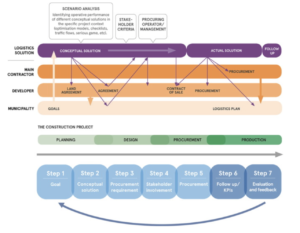The temporariness of construction supply chains, in combination with the multiplicity of stakeholders complicates the organization of construction logistics. The problem for cities today is not the construction materials’ transports as such, it is how to ensure accessibility and mobility for stakeholders during the construction time.
In general, there is no tradition of including different stakeholder perspectives when evaluating construction logistics setups. However, in other urban freight transport applications, multi-stakeholder dialogues are more common, and one methodology suggested and used as a Multi-Criteria Decision Analysis (MCDA) method is the Multi-Actor Multi-Criteria Analysis (MAMCA).
In a research paper Fredriksson et. at. develop a customized methodology for applying MAMCA in a construction logistics context, gradually refining the methodology along with five cases in three different countries. They show how MAMCA must be adapted to fit the construction context.
Effective stakeholder engagement is an important question in construction project management. However, as construction logistics solutions typically have an impact on several economic, social and environmental criteria (e.g. cost, speed, storage capacity, traffic safety, and environmental impact) and there are alternative ways to organize it, simply engaging stakeholders is not enough.
Instead, deploying Multi-Criteria Decision Analysis (MCDA) methods is appropriate for several stakeholder groups evaluating different alternatives. The main differences are predefined construction logistics alternatives, predefined actors and criteria groups, and the possibility of using the method in role-play to create awareness of stakeholder views in homogenous groups.
The methodology, developed for the CIVIC project, proved to be valuable for identifying relevant stakeholders and their criteria, identifying and understanding stakeholders’ preferences regarding construction logistics, and creating awareness of the need to initiate construction logistics in a project. Furthermore, it showed the need to clarify who is to take responsibility for initiating the use of construction logistics setups.
Source: Anna Fredriksson, Mats Janné, Pamela Nolz, Philippine de Radiguès de Chennevière, Tom van Lier, Cathy Macharis,
Creating stakeholder awareness in construction logistics by means of the MAMCA, City and Environment Interactions, 2021, 100067
For more information about the CIVIC project: click here.

